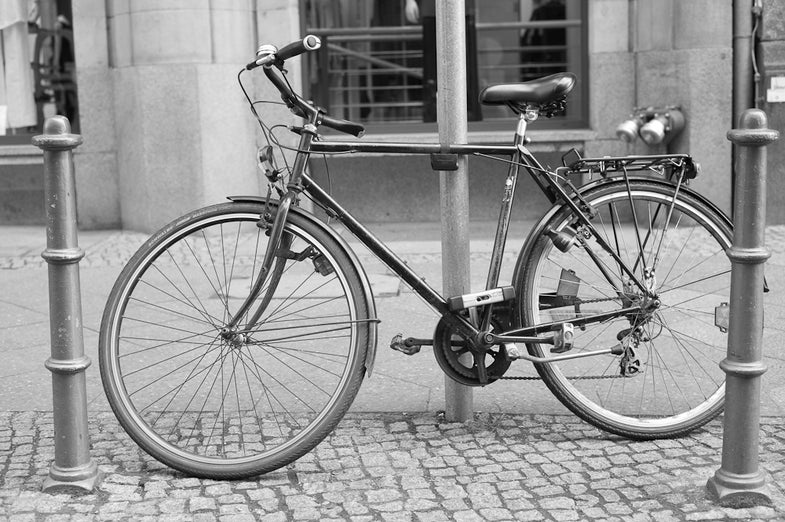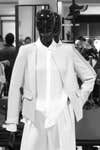First Impressions: Leica M Monochrom Black-and-White Digital Rangefinder
Does a digital camera without color images make sense here in the 21st century? I asked some Leica executives and shot a few pictures with it along the way

We may earn revenue from the products available on this page and participate in affiliate programs. Learn more ›
Just after announcing the M Monochrom black-and-white-only rangefinder in Berlin this weekend, Leica CEO Dr. Alfred Schopf looked at me with a subtle, confident smile: “If we had done the proper market research,” he said, “we probably never would’ve made this camera.” And when you consider the Monochrom M, his words aren’t hard to believe. Reactions to the unique new camera, which is incapable of capturing color images, swings wildly (and predictably) on the web from unadulterated lust to pure vitriol. But the fact of the matter is that very close to zero of those internet commenters have actually spent any time shooting with what is an undeniably interesting camera. I have, and I’m a little bit in love.
I should get it out in the open early that, without an unexpected Powerball jackpot hit, I’ll probably never own a Monochrom. I love black-and-white photography, and shooting with it was an experience I greatly enjoyed, but at $8,000 it’s as far out of reach for me as it is for almost everyone else.
But even though the Monochrom will never make its way into most of our bags, it’s still an incredibly important camera.
The foremost thing to consider is the technology. Yes, it’s pretty easy to suck the color out of a standard digital picture in Photoshop, which is why Leica went out of their way to ensure black and white photographers were actually getting something more out of the $1,000 premium the Monochrom brings over the $7,000 standard M9.
The 18-megapixel sensor itself is actually made by Trusense Imaging (the new name of Kodak’s former sensor manufacturing unit), and it functions much like any other imaging sensor, using millions of little pixels to gather up light and convert it into digital data. Like the M9—and also now the Nikon D800e—there’s no anti-aliasing filter between the sensor and the lens. But, because there’s no need for color data, they’ve also been able to ditch what’s known as the Bayer filter. As a result, more light gets through to the sensor, well over a full stop more or so Leica says.
In standard digital cameras, the Bayer filter is made up of green, red, and blue filters in a ratio of 2:1:1. Each pixel, then, can only provide information about one color of light. In order to create a coherent image, the camera does something called color interpolation.The Monochrom eschews all of that, though, and in return gets more light hitting the sensor and preserves more fine detail.”It’s not four times as much detail,” says Dr. Schopf, “but it’s easily on par with sensors as high as 30-megapixels.” We’ll know more about that when the camera gets our full lab test.
Removing the Bayer filter also has a noticeable effect when it comes to noise. You get slightly less of it thanks to the increase in light hitting the sensor. But, more importantly, the noise achieves a much more appealing pattern. It’s very film-grain-like. Even at ISO 10,000 the Monochrom manages to preserve an impressive amount of detail, especially in flat light.
This all may sound a bit dry for such a sexy camera, but it’s important to understand because it drastically affects the way you shoot with it. When you review your images, you get a histogram, just like you would on your current digital camera. However, the Monochrom’s histogram comes right from the RAW sensor data rather than a processed JPEG version. With a color camera, if you go a little too bright, you can usually pull some of that detail back from one of the color channels in Lightroom or Photohsop. With the Monochrom, though, anything that falls off the right boundary of the histogram is gone for good. As my new friend Sean Reid from ReidReviews.com said when out shooting, “Watch those highlights.”
Which brings us to the camera’s light meter. I, like many others who spend tons of time with modern DSLRs, am spoiled by fancy metering modes that continuously crunch huge amounts data before spitting out a shutter speed and an F-stop. The M meter is much simpler. It requires you to pay attention and often make judgement calls. I found myself making stupid mistakes when shooting with it, which had me thinking a lot harder about every image. I hated missing shots, but I loved how much it was drawing me into the process of taking pictures.
It also lacks many of the other creature comforts we’ve come to love on DSLRs. Burst rate (roughly 2 fps) is all but inconsequential, and you get only aperture priority or full-manual for your exposure modes. Oh, and then there’s the part where it doesn’t have autofocus. At all.
Since it’s functionally pretty much identical to the standard M9 (which itself is built on a system that’s changed very little since the 1950s), the average Leica shooter will feel right at home. The rest of us will need some practice.
But are there any pay-offs for making you do all that hard work? Certainly.
By now you’re surely dying to know about the image quality. Walking back to my hotel room with the memory card in my pocket, I couldn’t wait to look at the files. I didn’t care if I loved them or hated them. And in the end, it turned out to be a little bit of both.
From an ISO performance standpoint (again, we’ll delve much deeper into this during our full lab test), the images look fantastic. The maximum ISO has been turned up to 10,000, and as you can see in this sample, it handles that high setting like a champ. It has a surprising amount of fine detail that some other cameras would’ve lost in a muddy mess. Most importantly, it looks a lot more like actual film grain than it does noise. I found myself almost wanting to shoot at higher ISOs to see what the grain would bring to certain scenes. It’s a novelty that would eventually wear off, but for my first shots, it added an interesting aesthetic tool to play with.
Despite not having any color information, the Monochrom has an uncanny amount of dynamic range. Because of that, I was eager to check it out in high-contrast settings like this one and was very impressed by how much detail it could maintain. Bright white clothing on a dark, shiny black mannequin isn’t a simple thing to shoot, but the Monochrom nailed it. Once I got the exposure right, at least.
While shooting with the camera carries a learning curve, editing its output is actually pretty simple. RAWs come off the camera as black-and-white DNG files, so they’re easy to open without having to worry about proprietary file formats or software updates. That’s Leica’s standard operating procedure, but it’s even easier to appreciate with such a specialized camera. They also include a full version of Lightroom 4 and Nik Silver Efex 2 with the camera, which helps take a tiny bit of sting out of that $8,000 price tag.
Going through the files on my card, I found a lot of images on which I just plain blew it. My crappy rangefinder focusing skills claimed more than a couple victims. My inability to account for the Monochrom’s stripped down metering system claimed a few more. It proves that this camera is not for everyone. That’s the cost of keeping the Monochrom as close to a traditional film rangefinder as possible.
I did find the overall shooting experience to be very rewarding. The camera itself is as black as a camera could possibly be. In fact, when I picked up the camera and looked through the viewfinder for the first time, I actually expected, for a split second, that the view through the finder would also be stripped of color. It reminded me of something our editor-in-chief Miriam Leuchter told me: “Some shooters just see in black-and-white.” That’s who this camera is for.
I talked to Jonathan Roquemore from Magnum Photos, who said a lot of Magnum shooters are very excited about this camera—and that makes total sense. Leica expects that many photographers who continue to plow through rolls of B+W film today will flock to it, which raises an interesting question about what this camera says about the film industry overall.
“Color film may be almost completely gone in five years’ time,” said Leica Chairman Dr. Kauffman. “Black and white film will likely linger much longer. But, some shooters keep refrigerators full of their favorite stocks just in case.” And while film has been on an undeniable decline, Leica claims the demand for film cameras has remained absolutely steady for the past several years.
* * *
Ultimately, you probably made up your mind about whether you’d ever own an M Monochrom the second you first heard about it. I did. But, that’s the way Leica seems to want it. “We don’t go with the Best Buys of the world,” says Dr. Schopf. “Imagine if Circuit City had been one of our main distributors. It kills the brand.” That attitude has earned Leica a reputation that’s been interpreted over the years as everything from classy and exclusive to downright snobby.
They make it work for them, though. According to the execs, their highest-selling products are still mostly the priciest. “We put out the F/2.5 lens series and they’re great lenses, but people really want the best,” says Leica’s outspoken chairman, Dr. Andreas Kauffman. In fact, if you put in an order right now for the $11,000 50mm F/.95 Noktilux-M Aspherical lens, you can expect to wait up to a year for it.
But, just because the M Monochrom is out of reach doesn’t mean the concept of the exclusively black-and-white digital camera will stay that way. When asked if they were considering scaling it down a bit into something like their newly-announced X2 APS-C compact, they didn’t deny the possibility. “We’re obviously going to watch very closely to see how the Monochrom performs,” says Dr. Schopf. “We’ll have to start from scratch again to make it, but if this is such a huge success, then we’ll see.”
They likely won’t be the only ones monitoring its success, as other camera manufacturers will surely be curious about the demand. But I don’t expect to see another brand try it for some time. Leica has the rather unique ability in the industry to do small product runs while charging high prices for their stuff. According to Leica, the Monochrom was only in development for nine months from inception to production,which is very quick for a new camera. Combined with their built-in black-and-white user base, Leica seems like a perfect fit for a camera like this.
Some have guessed that Fujifilm would be next to try their hand at a black-and-white camera, but they’re just now rolling out their new X-Trans color sensor setup in the X-Pro 1, so I wouldn’t be surprised if they concentrated on that for a bit before jumping into the relatively risky waters of black-and-white digital photography. We’ll just have to wait and see on that front.
For now, most black-and-white purists will stick to conversions during post or pushing rolls of Tri-X through their film cameras while they still can. In all honestly, if you have decent post-processing chops and you’re not going to be making really big prints (qualifiers that probably apply to the vast majority of the folks reading this right now), you don’t need a $8,000 camera with a dedicated black-and-white sensor to get great results.
If the M Monochrom sells like some believe it will, price won’t always be an issue. Black-and-white as a format will certainly endure, but film stocks likely won’t. And if the demand is there, other companies will likely come to the party. They almost always do.
Writer’s Note: I’d like to thank Sean Reid of Reidreviews.com for letting me shoot with the M Monochrom he’s been testing and sharing some of his extensive knowledge about digital rangefinders with me. You can check out his full-on review over at Reidreviews.com (paid subscription required).






















